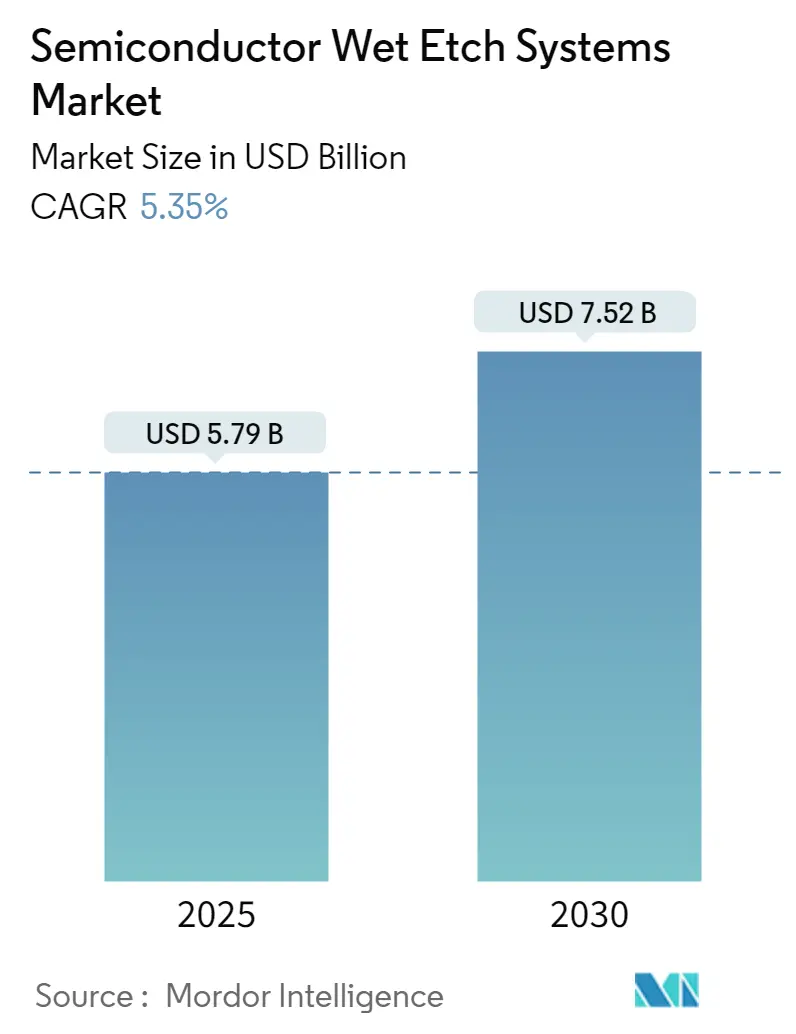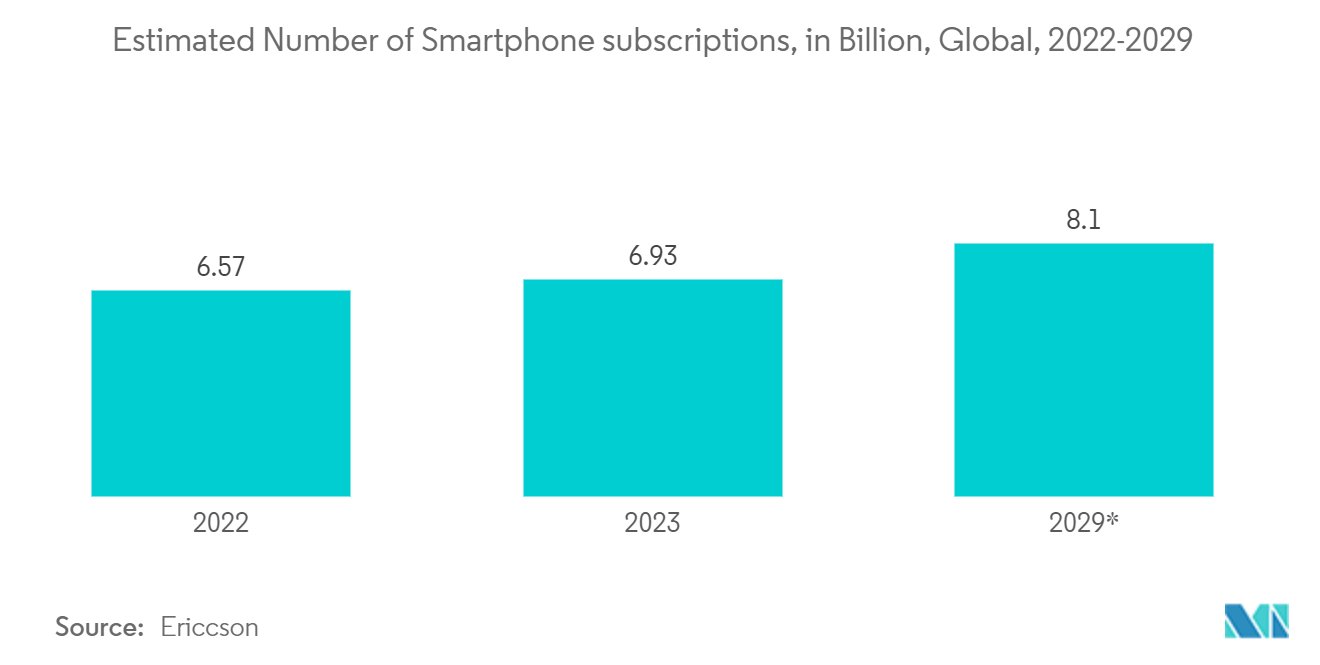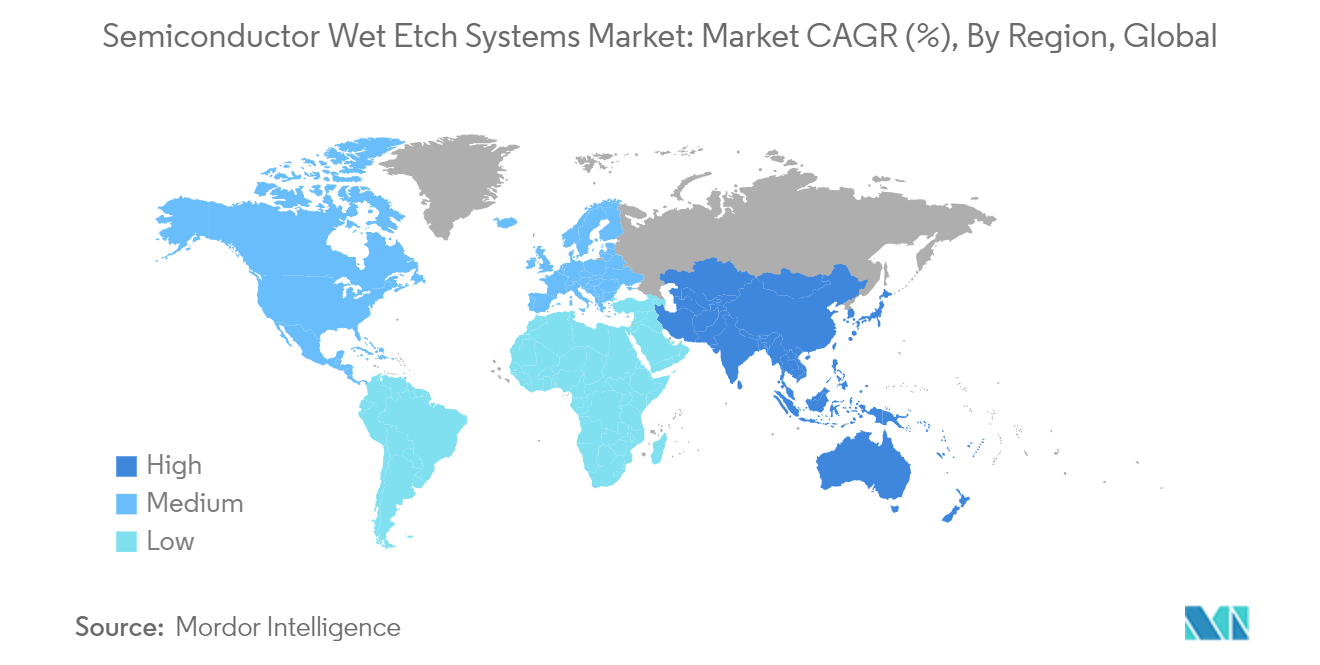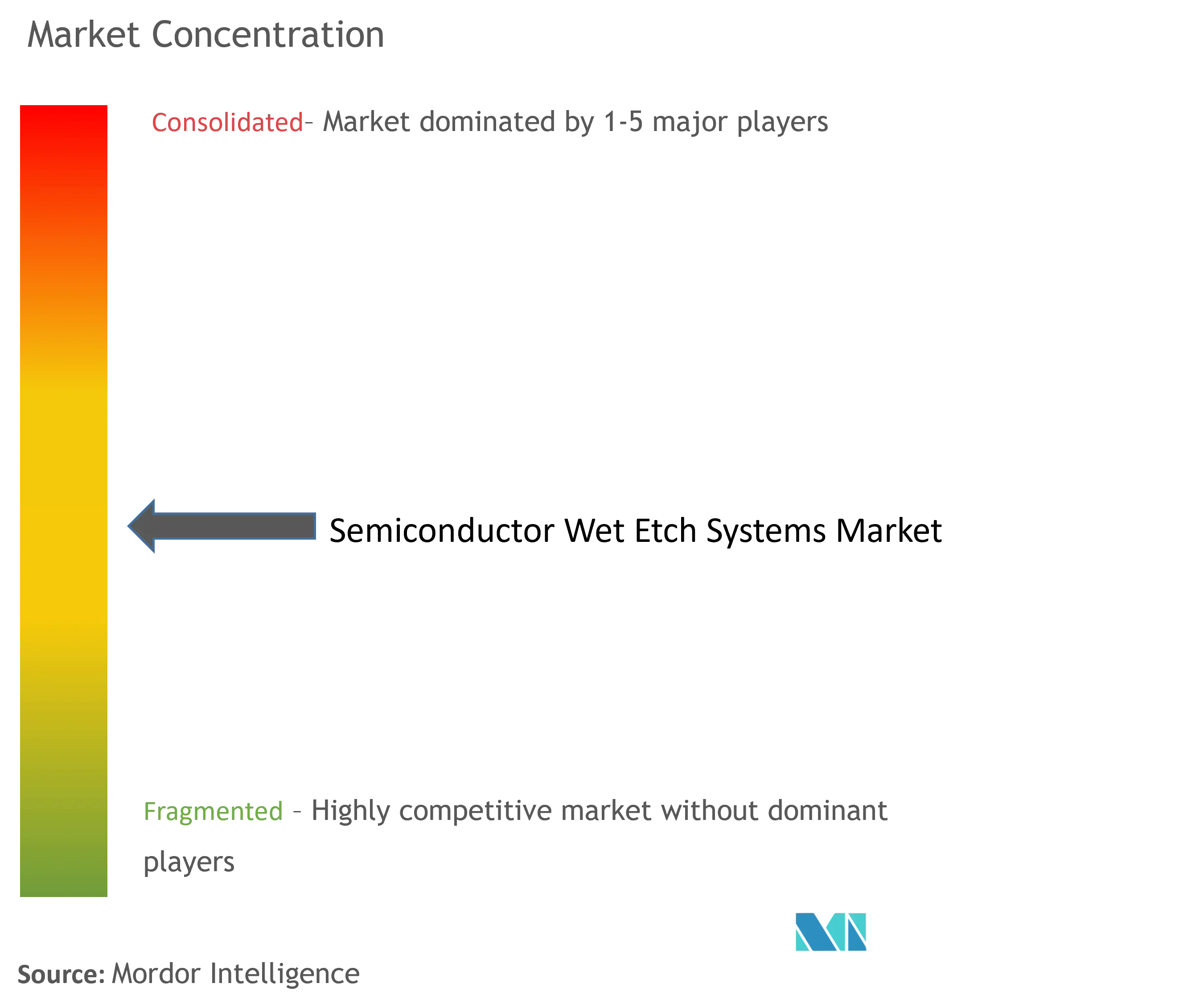Semiconductor Wet Etch Systems Market Size and Share

Semiconductor Wet Etch Systems Market Analysis by Mordor Intelligence
The Semiconductor Wet Etch Systems Market size is estimated at USD 5.79 billion in 2025, and is expected to reach USD 7.52 billion by 2030, at a CAGR of 5.35% during the forecast period (2025-2030).
Recognizing the strategic significance of semiconductors, governments across the world are prioritizing them for economic competitiveness and supply-chain resilience. The global chip shortage, a fallout from the recent crisis, highlighted how vulnerabilities in the semiconductor supply chain jeopardize technologies and products integral to daily life.
- Despite being developed, countries like the United States are susceptible to supply-chain disruptions. This vulnerability stems from their delayed support for the semiconductor sector, a domain where other nations have long recognized its strategic importance and provided fiscal backing. Heightened geopolitical tensions have intensified the urgency for some governments to fortify their positions in the global chip supply chain.
- As a case in point, the United States has unveiled an ambitious USD 52 billion initiative aimed at rejuvenating its chip manufacturing and research landscape. Globally, governments are reassessing their roles in the semiconductor value chain, formulating national industrial policies, and channeling substantial investments into domestic semiconductor manufacturing and R&D. Over the past few years, major players in the semiconductor arena, including China, Korea, and the EU, have collectively signaled potential government investments of around USD 250 billion over the next decade, all earmarked for the semiconductor industry. Such dynamics have catalyzed a pronounced increase in the global demand for front-end equipment, notably wet etch systems.
- Wet etch systems, pivotal in semiconductor fabrication, are instrumental in producing diverse devices, from microprocessors and memory chips to sensors. Consequently, heightened investments in chip fabrication are creating substantial opportunities in the market. With fabs poised to mitigate the ongoing semiconductor chip shortage, countries are witnessing a notable surge in investments. For instance, in January 2024, Tata Group revealed its intentions to establish a semiconductor fabrication plant in Gujarat, India, and is on the brink of announcing a significant fab in Dholera, Gujarat. Hence, such trends also create a favorable ecosystem for the studied market's growth.
- Additionally, integrated device manufacturers (IDMs) play a pivotal role, making substantial investments in wafer fabrication capacities. A testament to this is the June 2023 collaboration between Intel and the German government, which culminated in a revised letter of intent for a state-of-the-art wafer fabrication site in Magdeburg, backed by an investment exceeding EUR 30 billion for two pioneering semiconductor facilities in Europe. Similarly, in July 2023, Samsung committed USD 17 billion for a semiconductor fabrication plant on a sprawling 1,200-acre site in Austin, Texas. This strategic move comes as geopolitical strains between China and Taiwan have nudged chipmakers toward manufacturing in the United States, with Texas standing out due to its favorable tax environment and fresh subsidies.
- The factors driving the semiconductor wet etch systems market are increasing demand for semiconductors, technological innovations, and the rising embrace of advanced packaging technologies. Moreover, the escalating quest for sustainable energy is propelling the solar technology market, particularly boosting the demand for crystalline silicon PV cells. As the market for crystalline silicon solar cells expands, so does the need for wet etch systems. This is because wet anisotropic etching is crucial for the surface texturing of these solar cells, a process that minimizes light reflection and enhances productivity.
- The market continues to face challenges, such as the shift from wet etching to dry etching in certain emerging products and technologies within the electronics sector, which restrain the semiconductor wet etch system market's growth. Furthermore, with the wet etching process consuming significantly higher amounts of chemicals that are usually harmful to humans and the environment, the focus of the semiconductor industry toward sustainable manufacturing will also challenge the market's growth during the forecast period.
Global Semiconductor Wet Etch Systems Market Trends and Insights
The MEMS Segment is Expected to Observe Significant Growth
- Wet etch systems play a pivotal role in the aerospace and automotive sectors, instrumental in producing components like sensors and MEMS devices. These components are vital for electronic applications, especially in safety and control systems. For example, wet anisotropic etching is employed in silicon bulk micromachining to craft microstructures for diverse MEMS applications. The precision and reliability offered by wet etch systems make them indispensable in these high-stakes industries, where the performance and safety of electronic components are paramount.
- Moreover, the rising demand for consumer electronics, particularly smartphones, has driven the widespread adoption of MEMS devices, which play a pivotal role in these gadgets. For example, MEMS sensors facilitate functions like image stabilization and screen orientation in smartphones. Consequently, this heightened adoption of MEMS devices fosters a conducive environment for the market's growth in focus. Supporting this trend, Ericsson forecasts that by 2029, smartphone subscriptions will reach 8.1 billion. Such a surge in smartphone adoption highlights an increasing dependence on sophisticated electronic components, prominently featuring MEMS technology.
- While MEMS technology has made significant strides in communication and medical biotechnology, its expanding role in consumer electronics hints at even greater future advancements. Today, MEMS are ubiquitous, embedded in a range of products from smartphones to various consumer goods, underscoring their integration into daily life. The versatility and efficiency of MEMS technology continue to drive innovation across multiple sectors, enhancing the functionality and performance of everyday devices.
- MEMS technology, celebrated for its enhanced electrical performance at elevated frequencies, has extensive applications in smartphones, wearables, and various electronic devices. As the consumer electronics industry pivots from traditional sensors to embrace MEMS technology, the market's popularity is set to surge, consequently amplifying the demand for wet etch systems. This shift highlights the technological advancements within the consumer electronics sector and emphasizes the critical role of wet etch systems in supporting these innovations. The ongoing evolution of MEMS technology promises to unlock new possibilities and applications, further cementing its importance in the modern technological landscape.

Asia-Pacific is Expected to Grow at a Significant Rate
- Asia-Pacific (APAC), dominated by major players like China, Taiwan, and South Korea, has the highest market share in the semiconductor industry. CSET reports that barring assembly and packaging tools, China commands a significant share of the market across all primary segments.
- According to the ITA, semiconductors are South Korea's top export. The demand for semiconductor wet etch systems in the region is set to rise, fueled by heightened investments in chip production. For instance, in January 2024, South Korea unveiled its plans for the world's largest semiconductor cluster in Gyeonggi Province. With a projected investment of around USD 470 billion over 23 years, the country is partnering with industry giants Samsung Electronics and SK Hynix.
- The government is offering incentives like tax breaks and competitiveness enhancement programs. South Korea aims for a 50% self-reliance rate in essential chip manufacturing materials and machinery by 2030. These investments are poised to boost demand for front-end equipment in the region, creating a favorable ecosystem for the market's growth.
- As the demand for AI escalates in Taiwan, TSMC (Taiwan Semiconductor Manufacturing Company) is aggressively expanding its CoWoS (Chip-on-Wafer-on-Substrate) production. Moreover, OSAT (Outsourced Semiconductor Assembly and Testing) leaders, initially probing for orders, have ramped up their requests for advanced packaging. Suppliers like Scientech, providing CoWoS equipment, have seen a surge in orders for wet etching processing equipment, bolstering its demand in Taiwan.
- Furthermore, the recent semiconductor shortage issues have dragged the attention of other major economies in the region like India, Indonesia, Malaysia, and Vietnam, resulting in a significant growth in investments in new chip production and packaging facilities, which is also anticipated to support the studied market's expansion in the region in coming years.

Competitive Landscape
The semiconductor wet etch systems market is becoming increasingly competitive, with several major vendors holding significant market shares and maintaining strong distribution networks. At the same time, new players are making their mark. Industry leaders actively engage in mergers and acquisitions and forming strategic partnerships to strengthen their foothold and broaden their reach. Such maneuvers are crucial for staying ahead in this swiftly changing landscape. Prominent players in this sector include Hitachi High Technologies America Inc., ACM Research, Modutek Corporation, and Veeco Instruments Inc.
The market is set for a promising yet intricate future. Expected technological advancements and market dynamics will likely reshape the landscape, unveiling fresh avenues for growth and innovation. To navigate the evolving semiconductor wet etch systems market, stakeholders must adopt strategic foresight and proactively adjust to these emerging trends.
Techniques like atomic layer etching (ALE) and plasma-assisted wet etching are becoming increasingly popular due to their precision and control advantages. There is a heightened emphasis on sustainability, spurring the development of eco-friendly etching solutions and processes. Furthermore, the anticipated integration of artificial intelligence (AI) and machine learning (ML) is poised to bolster etching equipment capabilities, leading to enhanced process control and efficiency. Hence, vendors in the market should focus on developing systems in line with the evolving market trends to achieve sustainable growth and leverage emerging opportunities.
Semiconductor Wet Etch Systems Industry Leaders
-
Veeco Instruments Inc.
-
ACM Research
-
Hitachi High Technologies America
-
Alfa Laval Inc.
-
Modutek Corporation
- *Disclaimer: Major Players sorted in no particular order

Recent Industry Developments
- September 2024: ACM Research Inc. unveiled its Ultra C bev-p panel bevel etching tool, tailored for fan-out panel-level packaging (FOPLP) applications. This innovative tool specializes in bevel etching and cleaning for copper-related processes. Notably, it can manage bevel etching on both the front and back sides of the panel, all within a single system. Such versatility boosts process efficiency and bolsters product reliability.
- August 2024: Veeco Instruments Inc. revealed that IBM had chosen its WaferStorm Wet Processing System for Advanced Packaging applications. Furthermore, the two companies have inked a joint development agreement. This collaboration aims to delve into advanced packaging applications, leveraging various wet processing technologies from Veeco. As part of this partnership, the WaferStorm Wet Processing System will find its home at the Albany NanoTech Complex in Albany, NY. This facility is a hub for IBM and its ecosystem partners, who are at the forefront of R&D in advanced packaging and chiplet technologies.
Global Semiconductor Wet Etch Systems Market Report Scope
A semiconductor wet etch system plays a pivotal role in semiconductor manufacturing. This equipment selectively removes designated layers or regions from a semiconductor wafer using chemical solutions. The process entails immersing the wafer in a chemical solution known as an etchant, which dissolves or extracts the targeted material from the wafer's surface.
The study comprehensively analyzes trends and dynamics related to semiconductor wet etching systems. Revenue generated by vendors from selling semiconductor wet etch equipment has been tracked to derive the baseline for market estimations. Factors such as macroeconomic conduct, investments, and demand dynamics have also been considered to adjust the estimates and analyze the future dynamics of the market.
The semiconductor wet etch system market is segmented by type (isotropic wet etching and anisotropic wet etching), application (logic and memory, power device, mems, and other applications), and geography (North America, Europe, Asia-Pacific, Latin America, and Middle East and Africa). The market sizes and forecasts are provided in terms of value (USD) for all the above segments.
| Isotropic Wet Etching |
| Anisotropic Wet Etching |
| Logic and Memory |
| Power Device |
| MEMS |
| Other Applications |
| North America |
| Europe |
| Asia |
| Australia and New Zealand |
| Latin America |
| Middle East and Africa |
| By Type | Isotropic Wet Etching |
| Anisotropic Wet Etching | |
| By Application | Logic and Memory |
| Power Device | |
| MEMS | |
| Other Applications | |
| By Geography | North America |
| Europe | |
| Asia | |
| Australia and New Zealand | |
| Latin America | |
| Middle East and Africa |
Key Questions Answered in the Report
How big is the Semiconductor Wet Etch Systems Market?
The Semiconductor Wet Etch Systems Market size is expected to reach USD 5.79 billion in 2025 and grow at a CAGR of 5.35% to reach USD 7.52 billion by 2030.
What is the current Semiconductor Wet Etch Systems Market size?
In 2025, the Semiconductor Wet Etch Systems Market size is expected to reach USD 5.79 billion.
Who are the key players in Semiconductor Wet Etch Systems Market?
Veeco Instruments Inc., ACM Research, Hitachi High Technologies America, Alfa Laval Inc. and Modutek Corporation are the major companies operating in the Semiconductor Wet Etch Systems Market.
Which is the fastest growing region in Semiconductor Wet Etch Systems Market?
Asia Pacific is estimated to grow at the highest CAGR over the forecast period (2025-2030).
Which region has the biggest share in Semiconductor Wet Etch Systems Market?
In 2025, the Asia Pacific accounts for the largest market share in Semiconductor Wet Etch Systems Market.
What years does this Semiconductor Wet Etch Systems Market cover, and what was the market size in 2024?
In 2024, the Semiconductor Wet Etch Systems Market size was estimated at USD 5.48 billion. The report covers the Semiconductor Wet Etch Systems Market historical market size for years: 2019, 2020, 2021, 2022, 2023 and 2024. The report also forecasts the Semiconductor Wet Etch Systems Market size for years: 2025, 2026, 2027, 2028, 2029 and 2030.
Page last updated on:
Semiconductor Wet Etch Systems Market Report
Statistics for the 2025 Semiconductor Wet Etch Systems market share, size and revenue growth rate, created by Mordor Intelligence™ Industry Reports. Semiconductor Wet Etch Systems analysis includes a market forecast outlook for 2025 to 2030 and historical overview. Get a sample of this industry analysis as a free report PDF download.
.webp)


